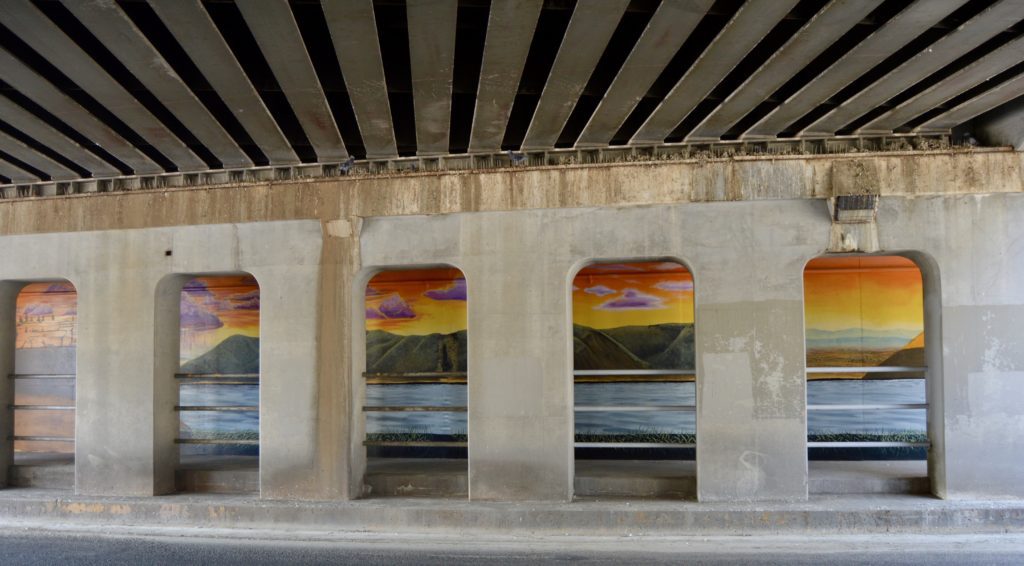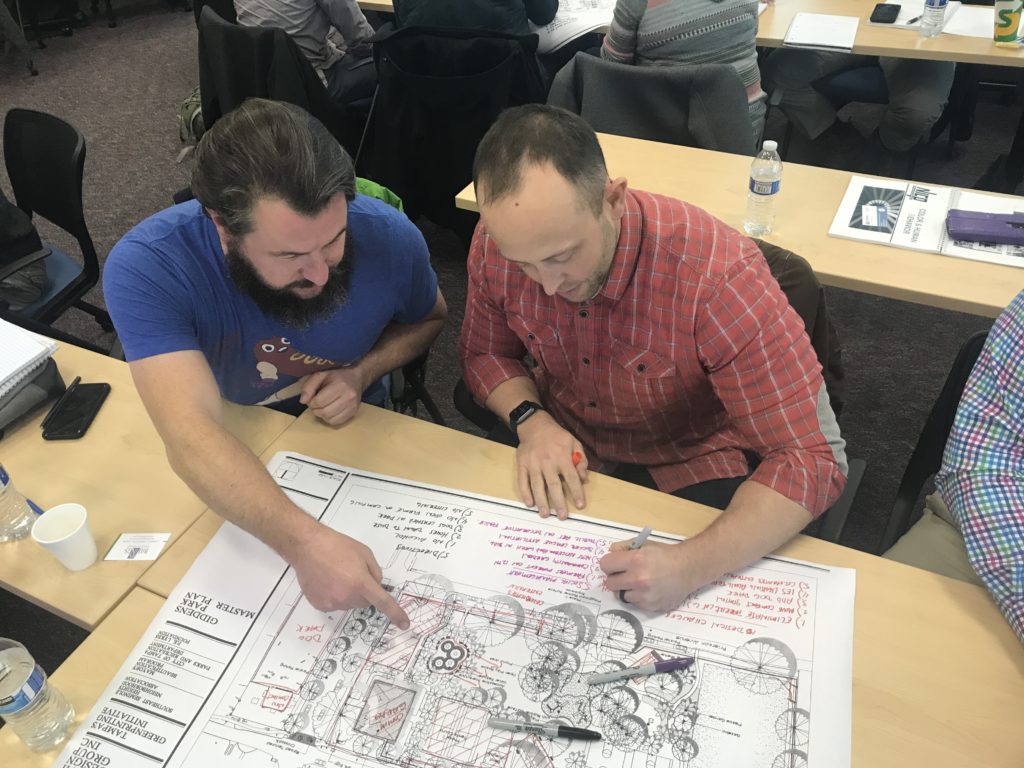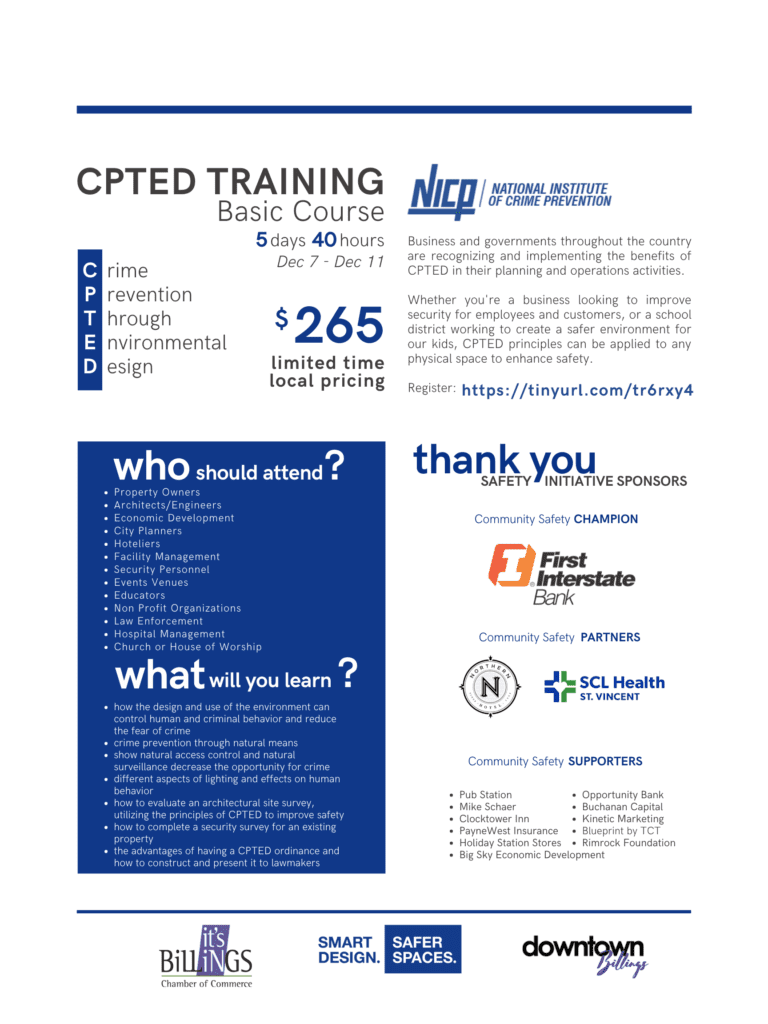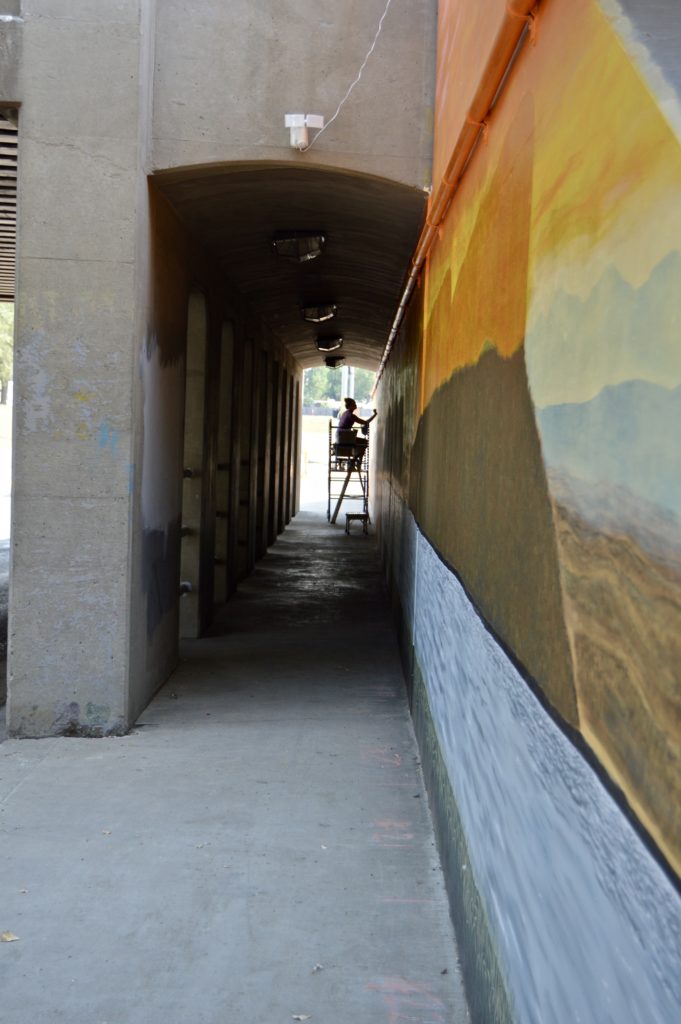BY DANIEL J. BROOKS, DIRECTOR; BUSINESS ADVOCACY
Public art installation in the alley of The Pub Station.
Photo courtesy Rhea Wolpoe.
There is a great public safety story happening in Billings right now and it’s probably not what you think. It doesn’t pertain to our esteemed safety officers, drug troubles, or the usual topics we associate with public safety. But it’s just as important.
I drive the 6th Street Underpass on a regular basis. Over the last six months the scourge of graffiti had taken over, canvassing the concrete and sending the message to passersby that vandals had claimed that territory. That was, until recently when a group of community members got together to reclaim the underpass, rolling vibrant hues over the spray painted tags.
But what does a beautification project have to do with public safety? As it turns out, removing graffiti, adding public art, and ensuring an area receives proper maintenance play a role in crime prevention. In fact they are all part of crime prevention through environmental design (CPTED), a strategy that, depending on how well it’s implemented, can reduce robberies between 30-84%. (Casteel, Carri and Corinne Peek-Asa. 2000. “Effectiveness of crime prevention through environmental design (CPTED) in reducing robberies.” American Journal of Preventive Medicine 18(4S): 99–115.)
I want to highlight these efforts because we need to keep this positive momentum. At the Billings Chamber we began our Smart Design. Safer Spaces. program in January, offering free security surveys to our businesses, as part of our Public Safety Priority. In the security surveys we recommend cost-effective safety improvements, which may have grants to help pay for them. Through the Downtown Billings Partnership, and thanks to City Council for approving the funds, businesses within the downtown tax increment finance district have access to matching funds for safety improvements recommended in a Smart Design. Safer Spaces. security survey.
Unfortunately, because of the pandemic we had to hit pause on our security surveys while we worked to address other needs in our business community: lobbying for businesses ordered to close, communicating a safe re-opening, and advocating for sensible adjustments to health guidelines. That work continues but has let up enough for us to shift attention back to other priorities like public safety.

So far we’ve completed security surveys for six businesses and intend to make it to the remaining 29 on our roster of sign-ups in the next 12 months. But like the underpass mural project, our efforts alone will not suffice to shift the public safety situation in Billings. We’ve made significant efforts to spread awareness of CPTED, it’s benefits, and how it works. We also need others in the community who can practice CPTED. Partly because we need to scale up implementation to have greater impact on Billings’ safety. But also, because we don’t intend to offer this service for free over the long term. This service could be a business that we’re hopeful an entrepreneurial Billings resident starts up. There are very few National Institute of Crime Prevention (NICP) certified CPTED Professionals in Montana (you can count me and the others on one hand). There’s clearly a need for the service, we just need someone with the background and passion to turn it into a thriving business—looking at you veterans and prior law enforcement folks.
NICP CPTED TRAINING DEC 7-11
The Billings Chamber and Downtown Billings Alliance are bringing a national CPTED training to Billings. The 5-day course provides 40 hours of instruction from the National Institute of Crime Prevention (NICP), covering all the basics of CPTED. Our hope is to get Billings business owners, architects, facility management personnel, and anyone else who wants to improve safety in Billings to attend. We want to empower more of our business community with the knowledge to see their environment with a keener eye on safety.

When I attended my CPTED training courses last year the majority of participants came from government—police, planning departments, school districts, and others. Many areas around the country have embraced CPTED, building it into their city ordinances, building requirements, and yearly evaluations. During my training in Grand Rapids, MI, I visited with staff from their chamber of commerce and downtown business organizations about a recently passed CPTED ordinance which received high praises from the positive effects it had in just a short time. In fact, day two of the Basic Course covers “Planning, Zoning, and CPTED,” noting that writing CPTED into city code is one of the most effective ways to implement the strategy.
More importantly we need our architects trained in CPTED, looking at their designs with crime prevention in mind. That’s not to say that they’re not already, but a few students in my courses were architects who felt the instruction and awareness of CPTED would really add to their abilities and the value of their designs, especially when discussing the design elements of special facilities like schools and hospitals. Even when looking at the design plans for typical commercial buildings our architects in the class realized some standard practices in design produce less-than-safe scenarios for shoppers. Ronda Carlson, a local architect with Cushing Terrell and fellow CPTED certified professional, explained how the training helped her and her firm, “For me as an architect, one of the benefits of having gone through the NICP course is applying CPTED analysis in the early design phase to identify where we can make changes to the physical environment that will reinforce positive behavior, and this is a lasting way to make a positive contribution to our community. And one of the great things about CPTED is that it encourages collaboration amongst a diverse group of stakeholders to help ensure all perspectives are considered in shaping our public places.”
Ultimately the goal is to make improvements to the environment around us that provides additional passive security, reducing opportunities for crime and increasing the perception of safety for residents. In doing so, we can take some of the burden off of our law enforcement. I can’t imagine our law enforcement officers would be too upset if the ever-increasing calls for service they have to deal with actually started to trend downward. If we can be smarter about the natural design of our environment, we can even reduce the burden on our property owners, who help pay for the provision of public safety through their taxes. Sean Lynch, co-owner of The Pub Station, implemented some of the recommendations after I completed a CPTED security survey of the property. “At the Pub Station, we followed the principals of CPTED and addressed issues that were easily remedied,” Lynch explained. “We added exterior art and lighting to our alley way. Since that change, we have seen a dramatic decline in crime related activities.”
Speaking of reducing costs, we’ve set the pricing for the 5-day course at a significantly lower rate than if you attended a class elsewhere. We recognize it may be difficult to spend 5 days in training, so we want to ensure the price doesn’t keep the Billings business community away. Since we can only have 50, we hope to have 25 from Billings register before we have to increase the price and open registration to others around the country. Ideally, we get a couple dozen Billings folks trained to help bring the knowledge of CPTED to our community and begin using that knowledge to increase our public safety. Register: https://tinyurl.com/tr6rxy4

CPTED CRITICISM
The murder of George Floyd has brought the issue of racism in our criminal justice system to the forefront of the national dialogue. Criticisms in other areas throughout the country— we haven’t implemented CPTED thoroughly enough to receive the charges—allege that CPTED is racist and criminalizes blackness. We acknowledge that racism remains a significant problem and our criminal justice system requires reform, but the allegation that CPTED, when implemented in its intended form, is inherently racist couldn’t be further from the truth.
One of the core concepts of CPTED, “Eyes on the Street” (the principle of natural surveillance), comes from author and activist Jane Jacobs. In her book, The Death and Life of Great American Cities, Jacobs highlights the need for recognizing your neighbor. “Eyes on the Street” is not about looking for suspicious activity but designing spaces that foster positive interactions. I see you; you see me. We acknowledge each other’s presence and humanity.
That is not to say that CPTED cannot be implemented in a racist way. Like any tool, it can be wielded in a constructive manner, or it can be used to harm. We believe that with proper training and understanding CPTED will be used as it was intended, avoiding contemptible misuses or profiling. Lastly, I would also encourage those who attend the CPTED training to get involved with the Chamber’s Equality of Opportunity group and learn how we can all work together toward a better Billings (BillingsChamber.com/EqualityofOpportunity).

RESOURCES MAP & ALTERNATIVE TO 911
Another way we are helping our business community is the production of a resource map that can orient folks in the right direction to get the health and human resource services they need. Originally developed a few years ago by an AmeriCorps Vista, we recently raised some money to cover the costs of revising and reprinting the map. Pictured on one side is a map of the downtown area, locating a few of the primary locations that could benefit our less fortunate. The other side lists out the services available, hours of operation, and contact information. While it’s not a comprehensive list covering the incredible number of services Billings offers, it’ll steer people to the help they need, opening one door that will hopefully lead to others.
Please let us know if you’re interested in obtaining these maps to have at your location (Daniel@ BillingsChamber.com). You can make it available to frontline staff who may often need to find or relay information to those in need of a hand up. Additionally, we want to prepare our businesses with good information. It’s not a crime to be homeless or have a mental health issue. There’s no need to dial 911 if there is no emergency or serious threat. That’s why we’ve added a reminder to notify other resources like Billings’ new Resource Outreach Coordinator, who is trained to work with those people suffering mental health and addiction issues. We’ve also listed a reminder that Montana 2-1-1 (simply dial 211 or visit montana211.org) is available and provides answers regarding housing and shelter, crisis care, mental health, addictions, and more.
While it won’t be on this version of the map, Billings will be adding another incredible resource to provide care to those in crisis—a mobile crisis unit. As part of their efforts to address ongoing addiction issues, our local Substance Abuse Connect committee has secured the funding and organized for the creation of a mobile crisis unit, on-call to provide care.
IMPROVING PUBLIC SAFETY IN BILLINGS
Our efforts at the Billings Chamber to address public safety needs are a small piece of the overall solution. Through our programs and partnerships we hope to create a safer Billings by making the physical environment safer and by redirecting calls for service to the appropriate agencies, freeing up our hard-working law enforcement officers to handle serious offenses like violent crime and drug trafficking.


